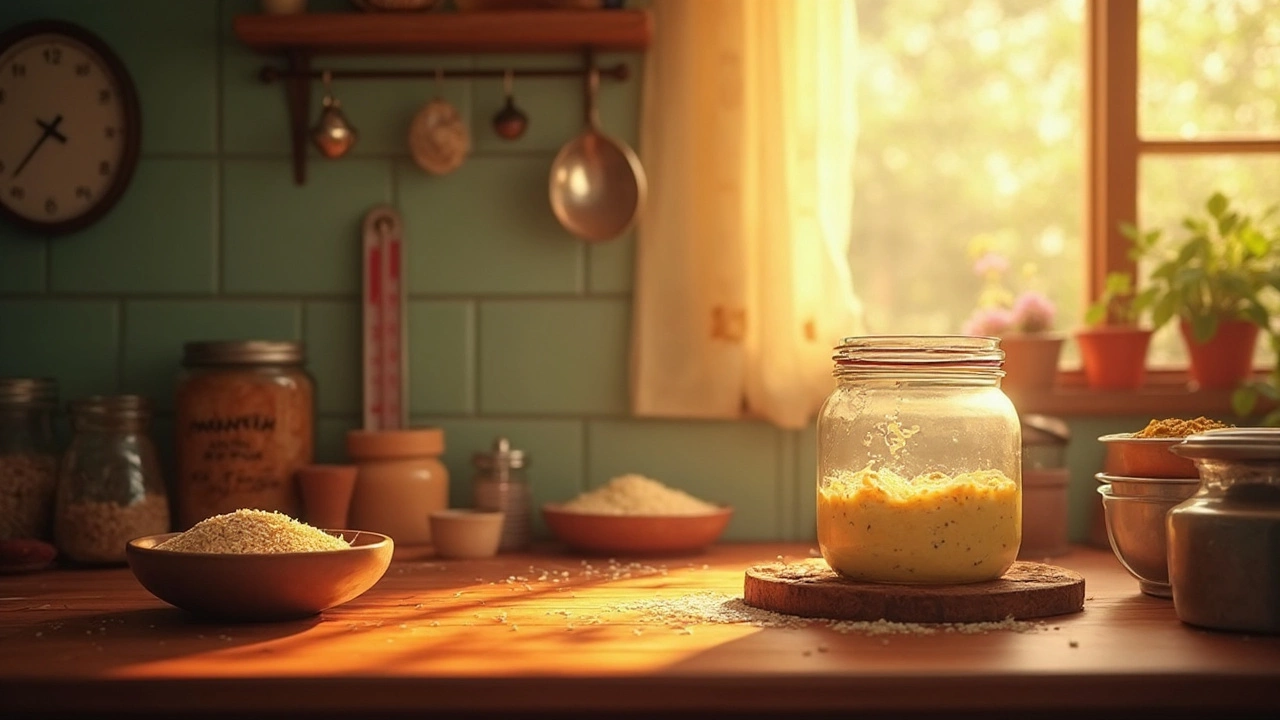Whoever said good things come to those who wait clearly didn’t have dosa cravings. Nobody wants to twiddle their thumbs for hours just waiting for batter to ferment. If you’re like me, loving a perfectly fluffy and crispy dosa but also seeking instant gratification, you’re in the right place. Let’s unravel the mystery of making that perfect batter ferment instantly.
First, let’s chat about what makes dosa batter tick—or rather, ferment. The magic lies in the lactobacillus bacteria and wild yeast going to work when you mix rice and urad dal (a type of lentil). But hey, you don’t have to wait for them to get their act together over hours, or sometimes, a day.
Here’s the trick: the environment. Most of our kitchens aren’t exactly hotbeds of fermentation-friendly temperatures. Try placing your batter in a slightly warm spot, like near a preheated oven or wrapped snugly in a kitchen towel. The cozy warmth will encourage those little bacteria to take action and do their thing quicker.
- Understanding Dosa Batter Basics
- Ingredients That Boost Fermentation
- Kitchen Environment Hacks
- Adjusting Your Recipe
- Instant Fermentation Techniques
- Common Mistakes to Avoid
Understanding Dosa Batter Basics
Alright, let’s break down what goes into making the perfect dosa batter. At its core, you need just a couple of ingredients: rice and urad dal (split black gram). The golden ratio for this mix is usually about 3:1, meaning three parts rice to one part dal.
Why these ingredients? Well, rice gives you that delightful crispiness, while the urad dal is the secret to the spongy fluffiness we all crave in our dosas. But here’s the kicker, both rice and dal need to soak. Ideally, for about four to six hours. This soaking is crucial because it softens the grains, making them easier to grind into a smooth paste.
Once soaked, the process moves to grinding. Using a wet grinder works best if you’ve got one handy, as it keeps the batter cool and aerated, helping fermentation later on. But if you don’t, a sturdy blender can work too. Just add water gradually until you hit that perfect, slightly thick batter consistency.
After you’ve got your batter, salt plays a part. Adding salt before fermentation isn't just for taste—it also helps the fermentation along. Just remember, don't overdo it; a pinch to taste usually does the trick.
Now, here's an often-overlooked tip: consistency. Think pancake batter – not too thick, not too thin. This allows better fermentation and spreadability on the pan, essential for when you’re about to make your dosa.
Understanding these basics can make all the difference when aiming for that ideal dosa texture. With this foundation, you're one step closer to mastering the art of quick dosa batter fermentation.
Ingredients That Boost Fermentation
If you're eager to whip up dosas in a jiffy, let's talk ingredients that kickstart fermentation. The first thing you can do is add a pinch of sugar. Yes, sugar isn't just for desserts; it fuels the yeast, speeding up the whole process. Just a teaspoon mixed into your batter can make a world of difference.
Another handy ingredient is fenugreek seeds. Besides their health benefits, they act like a magic wand, helping your batter ferment faster and improving texture. Adding a teaspoon of these seeds while soaking your rice and lentils can get things moving quicker.
Baking soda is another household hero. It won't replace the rich, tangy flavor of naturally fermented batter, but it will give it a nice boost if you're in a hurry. Stir in a tiny bit — about a quarter teaspoon per cup of batter — right before cooking.
For those who keep yogurt at home, it's your secret weapon. A tablespoon of yogurt in your dosa batter gets those friendly bacteria active and ready to rumble, especially if you live in a cooler climate like Auckland.
To make it even easier, here's a quick summary:
- Add a teaspoon of sugar to feed the yeast.
- Use fenugreek seeds to enhance flavor and fermentation.
- Incorporate a small amount of baking soda for instant lift.
- Mix in a tablespoon of yogurt for friendly bacteria.
Take charge of your fermentation with these simple ingredient tweaks and enjoy fast, delicious homemade dosas anytime!
Kitchen Environment Hacks
Creating the perfect kitchen environment can really give a boost to your instant fermentation process. The goal is to mimic the warm conditions that naturally speed up fermentation.
First off, temperature is your best friend. You’re aiming for a warm, cozy spot. If it's winter or relatively cool, you can place the batter near a warm oven. Just turn it on for a minute to generate some heat, and then place your bowl next to it.
If your kitchen has a microwave, here's a nifty trick: Heat a cup of water in the microwave for about 2 minutes. After removing the cup, quickly pop your bowl of batter inside and shut the door. The warm steamy environment will help ferment the batter faster.
Don’t leave your batter in a drafty area. Instead, wrap it up! Cover your bowl with a thick kitchen towel or even a cozy blanket. This will trap heat and speed up the process. Just like how you wouldn’t let yourself get cold in bed, keep your batter snug too.
Another clever hack is to use a yogurt maker if you have one lying around. The consistent warmth it provides is just what dosa batter needs to ferment properly and quickly.
Want more control? A thermostat-controlled heater placed in the vicinity can keep the area at a consistent temperature conducive to fast fermentation.
All these hacks are about keeping things warm. So think creatively about other heat sources in your kitchen that might do the trick. Remember, it’s the little tweaks that make the biggest difference in your dosa recipe.

Adjusting Your Recipe
Alright, let’s cut to the chase. If you want that dosa batter to get a move on, tweaking your recipe a bit can do wonders. Cooking is a bit of chemistry mixed with magic, right? So, let’s see how adjusting a few ingredients can speed up your fermentation process.
First up, fiddle with the rice-to-dal ratio. Usually, it’s about 3:1, but adding a bit more urad dal makes your batter lighter and gives those bacteria more to munch on. Try a 2.5:1 ratio instead. Also, throw in a handful of poha (flattened rice) to the mix. It absorbs moisture and helps create a softer batter.
Another tip is to use warm water when grinding the ingredients. And by warm, I mean like a cozy bath, not boiling. This little adjustment can make a significant difference because it kickstarts the bacteria’s activity. Don't you just love little hacks that make a big difference?
Consider adding a pinch of fenugreek seeds or methi. These tiny seeds are not just for slight flavor – they pack a punch in boosting fermentation. Who knew these little seeds could be so powerful?
Finally, you can add a touch of sugar—not too much, just a teaspoon for the entire batch. Sugar acts as a primer for fermentation, but don’t worry, your dosa won't turn into dessert.
Here’s how you could adjust your recipe:
- Rice to Urad Dal ratio: Use 2.5 cups rice and 1 cup urad dal.
- Poha addition: 1/2 cup poha added to your ingredients.
- Warm water: Use it to soak and grind.
- Fenugreek seeds: Add 1/2 teaspoon.
- Sugar: Just 1 teaspoon for the entire batch.
By making these small shifts in your recipe, you can give your instant dosa batter a fighting chance to ferment much faster, and before you know it, you’ll be enjoying the aroma of crispy dosas wafting through your kitchen.
Instant Fermentation Techniques
Alright, let’s dive into some no-nonsense methods to instantly ferment your dosa batter. You're looking to save time without losing out on taste or texture, right? Here's how you do it.
First off, adding a pinch of yeast can be your best friend. Just a little sprinkle goes a long way to kickstart the fermentation party. Mix this in well with your batter, and you'll see results quicker than you can say 'dosa'.
Another trick in the bag is using instant fermentation aids that are already in your kitchen. That half-used bottle of store-bought sourdough starter or buttermilk lying in your fridge? Perfect! Adding a tablespoon of either to your batter can ramp up the fermentation process significantly.
Temperature is another secret weapon. It's all about finding that Goldilocks zone—not too hot, not too cold. If it's cool in your kitchen, try creating a warm environment. Use your oven (turned off!) as a cozy fermentation chamber. Just preheat it for a few minutes and then turn it off before placing the batter inside.
- Yeast Addition: Add 1/4 teaspoon of yeast to your batter and mix well.
- Buttermilk or Sourdough Starter: A tablespoon is all you need to speed things up.
- Oven Hack: Preheat the oven for 5 mins to warm, then turn it off and let the batter sit inside.
If you’re really in a pinch, consider using a microwave. Yes, you heard that right. No, we’re not cooking the batter! Just warm a bowl of water in the microwave to create a humid environment, then place the batter bowl inside the microwave (turned off, of course). This creates a small fermentation sauna for your batter.
While these methods play a bit with tradition, they definitely don’t mess with flavor. In fact, they might just become your new go-to, especially when time's not on your side!
Common Mistakes to Avoid
Even though making instantly fermented dosa batter is a neat trick, there are a few speed bumps that can trip you up. Let’s call them out so you can dodge them easily.
First off, don’t overdo the warmth. While placing the batter near a warm spot is key, overheating can kill the friendly bacteria or yeast. If your batter is somewhere near a heater or you accidentally left it above your oven longer than intended, slow down. Too much heat is a recipe for disaster—or, well, unfermented batter.
Another biggie is the water ratio. It’s tempting to eyeball it, but too much water can make your batter runny and delay fermentation. Stick to the recommended proportions and adjust gradually if needed.
Now, don't skip the salt. There's a myth floating around that adding salt hinders fermentation. Not true! Salt actually controls the bacterial growth, preventing the batter from turning sour if left a tad too long. However, toss it in after the initial mixing—let the batter sit for a bit salt-free.
Let’s talk grinders. Using a regular blender instead of a proper wet grinder can be tempting, but it won’t achieve the same smooth texture or effective mixing of rice and dal. If you can swing it, invest in a wet grinder to make your instant dosa batter dreams come true.
If you’re thinking of instant yeasts or baking sodas as a fix-all, tread carefully. They can be handy, don’t get me wrong, but overuse can flat-out ruin the taste and authenticity. Measure these carefully or use them as a last resort.
Finally, don’t overlook the soak time. Even if you’re on the express train to fermented batter, giving your rice and dal ample soak time before grinding is crucial. Rush this step, and your batter might not ferment no matter what tricks you have up your sleeve.
Avoid these common missteps, and you'll be on your way to mastering the art of instant dosing without a hitch. Happy dosa making!
